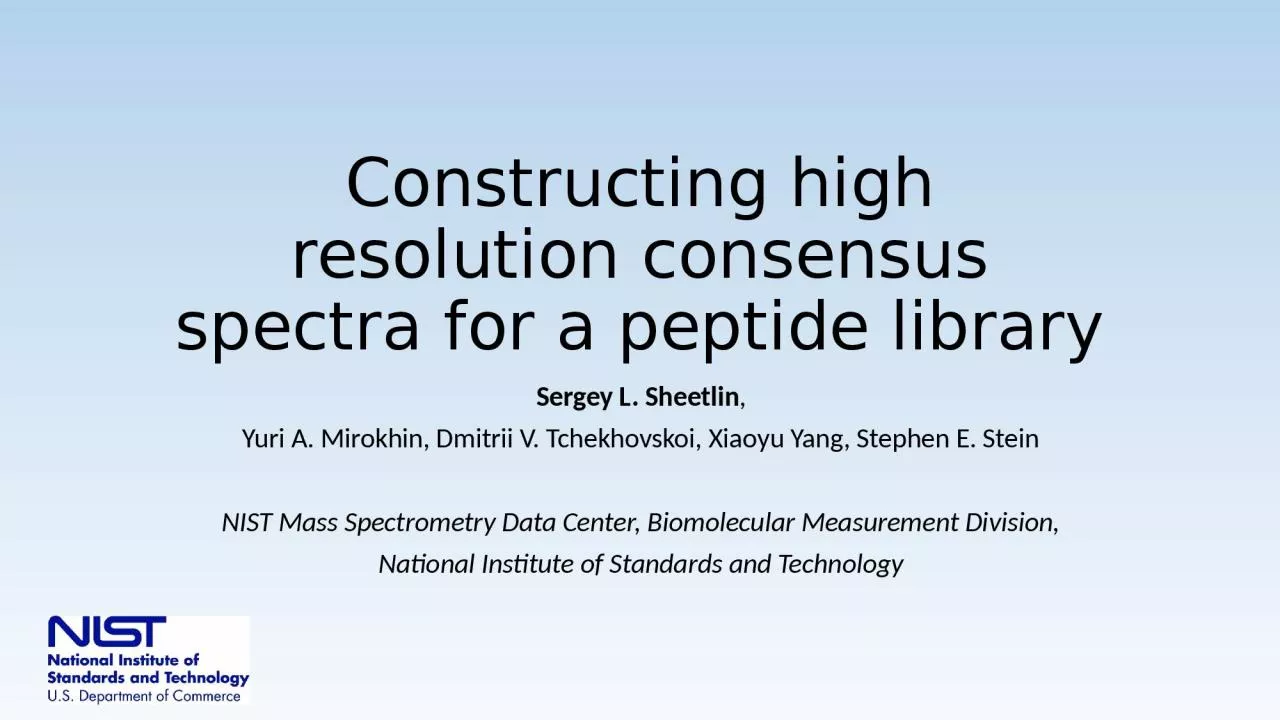

Sergey L Sheetlin Yuri A Mirokhin Dmitrii V Tchekhovskoi Xiaoyu Yang Stephen E Stein NIST Mass Spectrometry Data Center Biomolecular Measurement Division National Institute of Standards and Technology ID: 933680
Download Presentation The PPT/PDF document "Constructing high resolution consensus s..." is the property of its rightful owner. Permission is granted to download and print the materials on this web site for personal, non-commercial use only, and to display it on your personal computer provided you do not modify the materials and that you retain all copyright notices contained in the materials. By downloading content from our website, you accept the terms of this agreement.
Slide1
Constructing high resolution consensus spectra for a peptide library
Sergey L. Sheetlin,Yuri A. Mirokhin, Dmitrii V. Tchekhovskoi, Xiaoyu Yang, Stephen E. SteinNIST Mass Spectrometry Data Center, Biomolecular Measurement Division,National Institute of Standards and Technology
Slide2Tandem mass spectrometry
Sample
Ionization
m/z ion sorting
MS1 precursor ion
CID fragmentation
m/z ion sorting
MS2 product ions
Detection
(measuring m/z)
m/z: mass-to-charge ratio
CID: Collision-Induced Dissociation
MS: Mass Spectrum
Slide3Example of chromatogram (using Thermo
Xcaliber Qual Browser)
Relative abundance
Time (min)
Slide4Example of MS1 spectrum(using Thermo
Xcaliber Qual Browser)
Relative abundance
Slide5Example of high resolution MS2 spectrum(shown with NIST MS search program)
Relative abundance
Slide6Peptides
Short chains of amino acids connected by amide bondsGlu-Thr-Lys
ETK
Glutamylthreonyllysine
C
15
H28N4O7
Slide7Peptide libraries
NIST MS Search libraries of peptide spectra are available athttp://chemdata.nist.gov/dokuwiki/doku.php?id=peptidew:cdownload
Slide8Nomenclature for peptide CID fragment ions
R
1
R
2
R
n-1
Rn
| | | | H
2N-CH-CO-NH-CH-CO- …...-NH-CH-CO-NH-CH-CO2
H
I. A.
Papayannopoulos. The interpretation of collision-induced dissociation mass spectra of peptides. Mass Spectrometry Review, 14:49–73, 1995.
Slide9Computation of fragment masses
Slide10Peptides monoisotopic masses
20 amino acids residues and their monoisotopic masses
Ala
Arg
Asn
Asp
Cys
Glu
Gln
Gly
His
Ile
A
R
N
D
C
E
Q
G
H
I
71.0371
156.1011
114.0429
115.0269
103.0092
129.0426
128.0586
57.0215
137.0589
113.0841
Leu
Lys
Met
Phe
Pro
Ser
Thr
Trp
Tyr
Val
L
K
M
F
P
S
T
W
Y
V
113.0841
128.095
131.0405
147.0684
97.0528
87.032
101.0477
186.0793
163.0633
99.0684
Slide11Modifications
In vivo Posttranslational modifications (PTM) are covalent modifications of proteins after its translation. PTMs play role in activity, function of proteins and their interaction with other molecules.Modifications caused by sample preparation.
Modification name
Composition
Monoisotopic mass
Carbamidomethyl
C
2
H
3
NO
57.021464
iTRAQ4plex
H
12
C
4
13
C
3
N15NO
144.102063
Oxidation
O
15.994915
Deamidation
H
-1
N
-1
O
0.984016
Phosphorylation
HO
3
P
79.966331
Glu
->pyro-
Glu
H
-2
O
-1
-18.010565
Gln
->pyro-
Glu
H
-3
N
-1
-17.026549
Protein modifications for mass spectrometry
www.unimod.org
Slide12Fragments neutral losses
Common losses are H2O, NH3, CO, H3PO4,iTRAQ (H12C4
13
C
3
N
15NO).
Relative abundance
Slide13Peptide “GHVIAAR”; charge 2; modification iTRAQ4plex on the first AA ‘G’
Relative abundance
Slide14Experimental and theoretical isotopic peaks
Relative abundance
Valkenborg
, D.,
Mertens
, I.,
Lemiere
, F.,
Witters
, E.,
Burzykowski
, T.: The isotopic distribution conundrum. Mass
Spectrom
. Rev. 31(1), 96–109 (2012)
Slide15Annotation of peaks of experimental spectra
Slide16Experimental and theoretical densities
Probability density function
Slide17Experimental and theoretical densities
Probability density function
Slide18Experimental and theoretical densities
Probability density function
Slide19Error of annotation of experimental peaks
Probability density function
Slide20Statistics of different types of fragment ions(based on limited set of data)
Slide21Clustering experimental spectra
Set of unidentified MS2 spectra
Identification (peptide sequencing)
Grouping results by charge, peptide, modifications, collision energy
Filtering
Clusters of replicate spectra
Slide22Peptide sequencing algorithms
Database search: comparing theoretical spectra for sequences from a database with the query spectrumMS-GF+, Mascot etc.De novo sequencing: trying to find a peptide optimal in terms of some measure of similarity between its theoretical spectrum and the query spectrumPEAKS, NovoHMM etc.Library search: direct comparison of the query spectrum with identified spectra from a library
NIST Mass Spectral Library etc.
Slide23Example of experimental spectra from the same cluster
Relative abundance
Slide24Computing peaks of consensus spectra
Replicate spectra
Consensus
MS-GF+
Slide25Computing peaks of consensus spectra
Slide26Example of log-likelihood
Slide27Average fraction of replicates
Hypothesis: “good” peaks of the consensus spectrum have properties similar to annotated peaks
Slide28Filtering peaks of consensus spectra
Replicate number
Is there a peak in the replicate
corresponding to the
given consensus peak with abundance A?
1
Yes
2
Yes
…
…
N-1
No
N
Yes
Bernoulli distribution:
Yes
with probability p;
No
with probability 1-p
Slide29Density of peaks for different relative abundancies
Slide30Comparison of consensus and best replicate spectra
Slide31Further directions
Adjusting the parameters of the method for optimal performance of the existing search algorithmsBuilding peptide libraries of consensus spectra
Slide32Acknowledgements
NIST MS Data CenterYuri A. MirokhinDmitrii V. Tchekhovskoi
Xiaoyu Yang
Stephen E. Stein
William E. Wallace